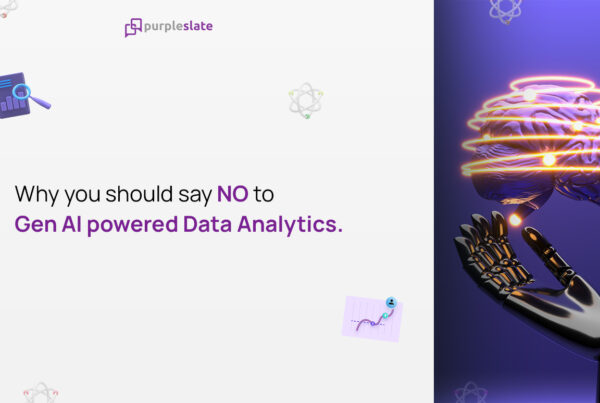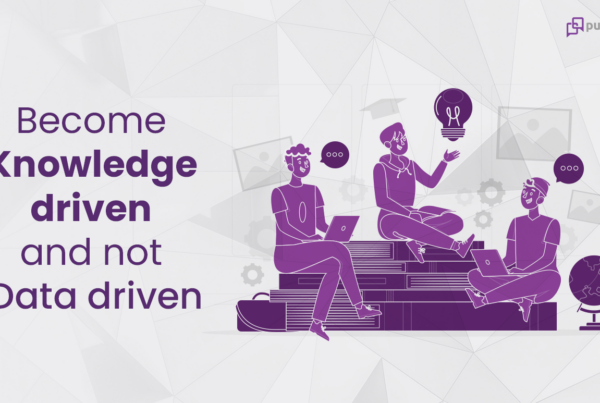
Introduction
Data has become the lifeblood of many organizations across the globe and data analytics helps the business make sense of data. Established enterprises have sophisticated systems to capture and store data. However, the reality for many organizations can be summarized in a single line.
“The Global Datasphere will reach 175 zettabytes by 2025” – IDC
Data, data, everywhere, not a byte that is useful…
Inside this goldmine of data, lies insights when unearthed can catapult organizations into a trajectory of high growth.
Unraveling the Concept of Data Analytics
Data analytics is the process of crunching data to understand patterns and trends from which meaningful insights for business decisions can be derived. It utilizes the concept of mathematics, advanced statistics, and basic querying capabilities to discover patterns and trends. The results are generally represented in a visual format like graphs or charts, which are later incorporated into various reports or dashboards.
It’s impossible to progress further without understanding the concept of business analytics.
Business Analytics
Business Analytics depends on certain components of data analytics including statistical analysis to understand the applications and implications of business data. Gartner defines business analytics as “solutions used to build analysis models and simulations to create scenarios, understand realities and predict future states. Business analytics includes data mining, predictive analytics, applied analytics, and statistics, and is delivered as an application suitable for a business user”
A Tale of Two Data Management Streams – Data Analytics vs Data Science
There are times when data science is often mistaken for data analytics. Data analytics is just a part of the broader spectrum of data science. Data science as a discipline delves deeper into understanding data at its core and helps data analysts go a long way by building, cleaning, and organizing large datasets. Data scientists make use of a variety of programming concepts, advanced statistical methods, and machine learning algorithms to shape raw data into something consumable.
There are three major processes in data science to convert data and make it more meaningful. The first one is data wrangling where data is cleansed and organized. Then comes statistical modeling, where data is subjected to different statistical analyses like regression, correlation, and cluster analysis, to understand the relationship between different variables. Finally, programming uses advanced languages to analyze large datasets effectively.
| Parameter | Data Science | Data Analytics |
| Scope | Macro in nature | Micro in nature, and is a subset of data science |
| Purpose | Discovering new questions to drive innovation and predict the future behavior of data | Derive actionable insights from the subset of required data and present in visual formats or reports |
| Skillset | Advanced programming skills coupled with deep knowledge in statistical methods | Basic programming skills coupled with basic knowledge of statistical methods |
| Type | All kinds of data are handled by data scientists | Majorly structured data is required by data analysts to draw insights |
The Path to Evolution – Four Stages of Data Analytics
Data analytics is a journey and not just a milestone. Data as a culture need to form a central core of the organization’s change management strategies. Then they will be able to appreciate the concept of data analytics as a journey. This journey has four important stages. Across the internet, these stages are called types of data analytics, however, each of them is essential for today’s organizations.
Progressing through the four stages of the analytics maturity curve will define an organization’s success ratio. The four stages are detailed below.
Descriptive analytics
Often called the starting point of analytics, descriptive analytics deals with breaking down big numbers into consumable smaller formats. It helps in understanding basic trends but doesn’t help with deeper analysis. It stops at answering the “what”. Small everyday operations rely on descriptive analytics for their day-to-day planning.
Diagnostic analytics
The next step in the analytics journey, diagnostic analytics is aimed at understanding the “why” behind an occurrence. Studying the cause will help organizations mitigate or plan better for their future. Diagnostic analytics uses data drilling, data mining, and correlation analysis to uncover underlying causes. A simple example would be when product marketing teams are planning for a product launch campaign, diagnostic analytics reports of previous campaigns will help them plan better.
Predictive analytics
As the name suggests, predictive analytics is the science of predicting future scenarios in business based on historical data. It relies on advanced statistical analysis, data mining, and machine learning for the system to come out with a comprehensive prediction. It helps business leaders in data-driven decision-making and proactively mitigating risks. An everyday example would be analyzing a potential candidate’s past payment behavior and predicting on-time payment probability for a bank to extend credit lines.
Prescriptive analytics
Being the final stage, prescriptive analytics feeds on the results of descriptive, diagnostic, and predictive analytics results to suggest a probable cause of action and help businesses make informed decisions. Jack-riding on the previous example, if the individual was a serial defaulter, then the system can suggest the mortgage officer not to sanction loans for the individual as he has a history of defaulting and his credit scores are a mess.
Defining the Need – Modern-Day Use Cases for Data Analytics
Personalize Customer Journeys
Businesses collect customer data at various touch points including but not limited to traditional brick and mortar shops, e-commerce websites, mobile applications, social media sites, and finally through your friendly neighborhood cookies. The modern digital-driven consumer behavior is fickle and to get insights into that, analytics on the collected data is very important. This can help businesses deliver tailored customer experiences and have a better opportunity to convert as well as retain customers.
Analyze Gaps in the Supply Chain
Supply chain is a critical function of the organization and is very sensitive in terms of processes. A minute mistake can snowball into a major disaster. Data analytics is the unsung hero, who protects the supply chain day and night behind the scenes. It reveals probable bottlenecks, cancels out bullwhip effects, and helps operations manage inventory without overstocking.
Anticipate and Mitigate Risks
In business, there are risks everywhere. Customer or staff theft, uncollected receivables, worker safety, and legal liability are among them. Data analytics may help a corporation evaluate risks and take preventive measures. For instance, a retail chain may employ a propensity model, which is a statistical method for predicting future behaviors or occurrences, to discover which stores are most prone to theft. The corporation may then use this data to determine the amount of security necessary at the stores, and also if it should divest from any places.
Closing Comments
Data analytics is one of the fastest adopted methodologies in the data management space. Organizations across the world accelerated their adoption of data analytics with more sophisticated tools in the wake of the pandemic. Given the volatility of the current market space and global economic conditions, data analytics will play a major role in the future successes of the business, especially in this cloud-native era.
Interested to know more about other data analytics terms? Head over to our data glossary page where more data management and analytics-related concepts are discussed.




